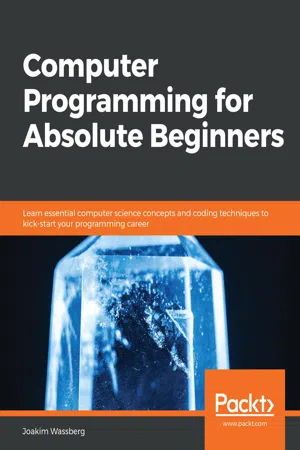
Computer Programming for Absolute Beginners
Learn essential computer science concepts and coding techniques to kick-start your programming career
- 430 pages
- English
- ePUB (mobile friendly)
- Available on iOS & Android
Computer Programming for Absolute Beginners
Learn essential computer science concepts and coding techniques to kick-start your programming career
About This Book
Get to grips with the building blocks of programming languages and get started on your programming journey without a computer science degree
Key Features
- Understand the fundamentals of a computer program and apply the concepts you learn to different programming languages
- Gain the confidence to write your first computer program
- Explore tips, techniques, and best practices to start coding like a professional programmer
Book Description
Learning how to code has many advantages, and gaining the right programming skills can have a massive impact on what you can do with your current skill set and the way you advance in your career. This book will be your guide to learning computer programming easily, helping you overcome the difficulties in understanding the major constructs in any mainstream programming language.
Computer Programming for Absolute Beginners starts by taking you through the building blocks of any programming language with thorough explanations and relevant examples in pseudocode. You'll understand the relationship between computer programs and programming languages and how code is executed on the computer. The book then focuses on the different types of applications that you can create with your programming knowledge. You'll delve into programming constructs, learning all about statements, operators, variables, and data types. As you advance, you'll see how to control the flow of your programs using control structures and reuse your code using functions. Finally, you'll explore best practices that will help you write code like a pro.
By the end of this book, you'll be prepared to learn any programming language and take control of your career by adding coding to your skill set.
What you will learn
- Get to grips with basic programming language concepts such as variables, loops, selection and functions
- Understand what a program is and how the computer executes it
- Explore different programming languages and learn about the relationship between source code and executable code
- Solve problems using various paradigms such as procedural programming, object oriented programming, and functional programming
- Write high-quality code using several coding conventions and best practices
- Become well-versed with how to track and fix bugs in your programs
Who this book is for
This book is for beginners who have never programmed before and are looking to enter the world of programming. This includes anyone who is about to start studying programming and wants a head start, or simply wants to learn how to program on their own.
Frequently asked questions
Information
Section 1: Introduction to Computer Programs and Computer Programming
- Chapter 1, Introduction to Computer Programs
- Chapter 2, Introduction to Programming Languages
- Chapter 3, Types of Applications
- Chapter 4, Software Projects and How We Organize Our Code
Chapter 1: Introduction to Computer Programs
- A perspective on the history and origins of the computer
- Background knowledge of the original ideas behind programming
- Understanding what a computer program is
- Learning how a computer program works
- An understanding of what machine code is
A brief history of computing

![Figure 1.2: Betty Jean Jennings and Fran Bilas, both programmers, operate ENIAC's main control panel – U. S. Army Photo (Public Domain [PD])](https://book-extracts.perlego.com/1694601/images/B15554_01_02-plgo-compressed.webp)
A brief history of programming

Table of contents
- Computer Programming for Absolute Beginners
- Why subscribe?
- Preface
- Section 1: Introduction to Computer Programs and Computer Programming
- Chapter 1: Introduction to Computer Programs
- Chapter 2: Introduction to Programming Languages
- Chapter 3: Types of Applications
- Chapter 4: Software Projects and How We Organize Our Code
- Section 2: Constructs of a Programming Language
- Chapter 5: Sequence – The Basic Building Block of a Computer Program
- Chapter 6: Working with Data – Variables
- Chapter 7: Program Control Structures
- Chapter 8: Understanding Functions
- Chapter 9: When Things Go Wrong – Bugs and Exceptions
- Chapter 10: Programming Paradigms
- Chapter 11: Programming Tools and Methodologies
- Section 3: Best Practices for Writing High-Quality Code
- Chapter 12: Code Quality
- Appendix A: How to Translate the Pseudocode into Real Code
- Appendix B: Dictionary
- Other Books You May Enjoy